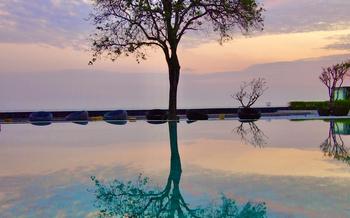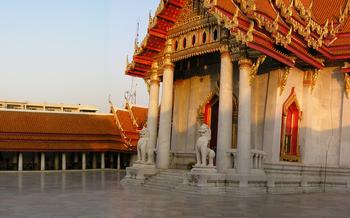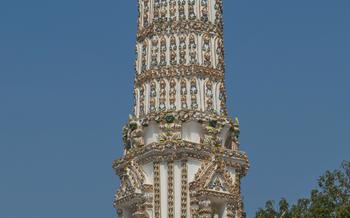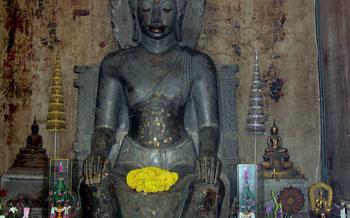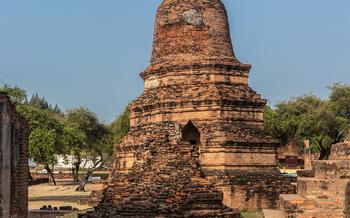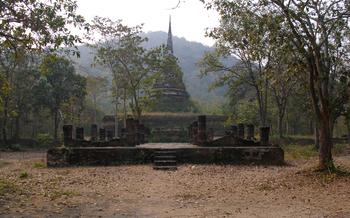
Wat Tantayapirom Phra Aram Luang
- , commonly known as Wat Tantayapirom, stands as a prominent Buddhist temple in Trang, Thailand. Its history dates back to the early 19th century when it was established by a revered monk named Luang Pho Tuad. Since then, the temple has undergone several renovations and expansions, becoming a significant spiritual and cultural landmark in the region.
- The Grand Ubosot (Ordination Hall)
- The Serene Wihan (Assembly Hall)
- The Beautiful Sala Kan Parian (Prayer Hall)
- The Surrounding Community
- Best Time to Visit
- Getting There
- Temple Etiquette and Dress Code
- Photography and Videography
- Insider Tip: Hidden Gem
, commonly known as Wat Tantayapirom, stands as a prominent Buddhist temple in Trang, Thailand. Its history dates back to the early 19th century when it was established by a revered monk named Luang Pho Tuad. Since then, the temple has undergone several renovations and expansions, becoming a significant spiritual and cultural landmark in the region.
Architecturally, Wat Tantayapirom showcases a blend of traditional Thai and Chinese influences. Its intricate carvings, colorful murals, and towering spires captivate visitors with their artistic beauty. The temple holds deep religious and cultural significance for the local community. It serves as a place of worship, meditation, and community gatherings, fostering a strong sense of spiritual connection and unity among the people of Trang.
When visiting Wat Tantayapirom, it is essential to adhere to temple etiquette and dress code. Visitors should dress modestly, covering their shoulders and knees. Shoes must be removed before entering certain areas of the temple, and visitors are expected to maintain a respectful and quiet demeanor. By observing these guidelines, visitors can show their respect for the sacredness of the temple and its religious significance to the local community.
The Grand Ubosot (Ordination Hall)
The Ubosot, or ordination hall, is the main sanctuary of Wat Tantayapirom, where important religious ceremonies and rituals take place. Its architectural design is a testament to the exquisite craftsmanship and attention to detail that went into its construction. The intricate carvings, delicate stucco work, and colorful murals adorn the exterior, creating a visually stunning masterpiece.
Inside, the Ubosot is equally impressive, with its soaring ceilings, polished marble floors, and an array of sacred Buddha images. The walls are adorned with vibrant murals depicting scenes from the life of Buddha, intricate Jataka tales, and significant events in Buddhist history. These murals serve as a visual narrative, educating and inspiring devotees as they contemplate the teachings of the Buddha.
The most sacred object within the Ubosot is the principal Buddha image, which is often a large, gilded statue seated in a meditative posture. This image is the focal point of worship and devotion, and visitors are encouraged to pay their respects by offering flowers, incense, and candles. The atmosphere within the Ubosot is one of reverence and tranquility, inviting visitors to find inner peace and spiritual connection.
The Serene Wihan (Assembly Hall)
The Wihan, or assembly hall, at Wat Tantayapirom Phra Aram Luang holds a significant place in the temple's daily life and religious activities. Its traditional Thai architecture showcases intricate carvings and decorative elements, reflecting the rich cultural heritage of the region. Inside, the Wihan houses important Buddha images and religious artifacts, creating a serene atmosphere for meditation, chanting, and spiritual gatherings.
The Wihan serves as a central meeting point for monks to conduct daily prayers, teachings, and ceremonies. It's a place where the community comes together to participate in religious events, listen to Dharma talks, and seek guidance from the monks. The Wihan's serene ambiance and sacred atmosphere make it an ideal space for spiritual reflection and contemplation.
Visitors to the temple are welcome to enter the Wihan and observe the monks' daily routines and rituals. It's an opportunity to learn about Buddhist teachings and practices, witness the devotion of the local community, and experience the tranquility of a sacred space. Remember to maintain a respectful demeanor, remove your shoes before entering, and avoid causing any disruption during religious activities.
The Beautiful Sala Kan Parian (Prayer Hall)
Within the temple complex, the Sala Kan Parian stands as a testament to the intricate artistry and cultural significance of Wat Tantayapirom. This prayer hall is a sight to behold, adorned with exquisite carvings and ornate decorations that showcase the dedication of its creators.
The Sala Kan Parian serves as a gathering place for monks and devotees, providing a tranquil space for prayer and contemplation. Its architecture reflects traditional Thai style, with elegant pillars supporting a gracefully curved roof. The walls are adorned with intricate bas-reliefs depicting scenes from Buddhist mythology, adding to the serene and spiritual atmosphere.
Inside the prayer hall, visitors can marvel at the beautiful Buddha images enshrined within. The statues exude a sense of peace and tranquility, inviting visitors to reflect on the teachings of the Buddha. The Sala Kan Parian is not only a place of worship but also a symbol of the community's devotion and cultural heritage.
Whether seeking a moment of quiet contemplation or simply admiring the stunning craftsmanship, the Sala Kan Parian is a must-visit for anyone exploring Wat Tantayapirom. Its beauty and serenity make it a memorable part of any visit to this sacred temple.
The Surrounding Community
The community surrounding Wat Tantayapirom Phra Aram Luang is known for its warm hospitality and welcoming nature. Visitors are greeted with smiles and friendly greetings, creating a sense of belonging and camaraderie. Engaging with the local people offers a glimpse into their unique way of life and rich cultural traditions. Take the opportunity to interact with them, learn about their history, customs, and beliefs. Support local businesses by trying the delicious regional cuisine, buying souvenirs, or participating in community activities. Exploring the surrounding area reveals hidden gems and attractions, such as serene countryside landscapes, vibrant markets, and historical landmarks. Embrace the opportunity to immerse yourself in the local culture and forge lasting connections with the people of Trang.
Best Time to Visit
Deciding on the best time to visit Wat Tantayapirom depends on personal preferences and interests. To enjoy pleasant weather, it's advisable to visit during the dry season, which typically runs from November to April. During this time, the skies are clear, humidity is low, and the temperature is comfortable, making it ideal for exploring the temple grounds.
For those interested in experiencing the temple's vibrant festivals, it's recommended to plan the visit accordingly. The main temple festival, known as the "Wat Tantayapirom Phra Aram Luang Fair," takes place annually in March or April. This lively event features colorful parades, traditional performances, and a variety of food stalls.
If seeking a more serene and contemplative atmosphere, consider visiting during the shoulder months (May-June and September-October). While the weather may be slightly warmer and humid during these months, the crowds are usually smaller, allowing for a more peaceful and immersive experience.
No matter when you choose to visit, Wat Tantayapirom offers a unique and enriching experience for travelers seeking to explore Thai culture, history, and spirituality.
Getting There
Reaching Wat Tantayapirom Phra Aram Luang is a breeze, with multiple transportation options available. Public transportation is a convenient and budget-friendly choice, with buses and songthaews (shared taxis) running regularly from Trang town. Simply hop on one of these and ask to be dropped off at the temple.
If you prefer a more private and flexible mode of transport, taxis and tuk-tuks are readily available for hire. Negotiate a price before your journey, and they'll whisk you straight to the temple's doorstep. Renting a vehicle, such as a motorbike or a car, offers the ultimate freedom to explore Trang at your own pace. Several rental shops are located in Trang town, offering a range of vehicles to suit your needs and budget.
Once you're on the road, follow the signs to Wat Tantayapirom, which is well-marked from the main roads. Ample parking space is available within the temple grounds, ensuring a hassle-free visit.
Insider Tip: If you're driving, keep an eye out for the stunning views of Trang's countryside along the way. Don't forget your camera to capture these picturesque moments!
Temple Etiquette and Dress Code
When visiting Wat Tantayapirom, it is essential to observe proper temple etiquette and dress code to show respect for the sacredness of the place and its religious significance. Here are some guidelines to follow:
- Attire: Dress modestly and appropriately, avoiding revealing or overly casual clothing. Shoulders and knees should be covered.
- Footwear: Remove your shoes before entering the temple's main buildings, such as the Ubosot and the Wihan. This is a sign of respect and cleanliness.
- Behavior: Maintain a respectful demeanor and avoid loud noises or disruptive behavior. This includes refraining from smoking, chewing gum, or eating within the temple grounds.
- Silence: Observe silence while inside the temple buildings. This creates a peaceful atmosphere for prayer and meditation.
- Photography: Be mindful of where you take photos and videos. Avoid capturing images of monks or other people without their permission.
Photography and Videography
Photography and videography are generally permitted within the temple grounds, allowing visitors to capture the beauty and essence of Wat Tantayapirom through images. However, it is important to be respectful and mindful of the sacred nature of the temple. Before taking any photos or videos, visitors should seek permission from the monks or temple authorities, especially when photographing religious ceremonies or rituals. It is important to use photography responsibly, ensuring that the privacy of other visitors and the sanctity of the temple are respected. Avoid using flash photography near Buddha images or in areas where it may be disruptive. When capturing images, focus on the architectural details, serene ambiance, and the vibrant colors that make Wat Tantayapirom a visually stunning destination.
Insider Tip: Hidden Gem
Beyond the main temple buildings, Wat Tantayapirom holds a hidden gem that few visitors know about. Tucked away in a serene corner of the complex is a secret garden, a tranquil oasis that invites contemplation and inner peace. This hidden sanctuary is adorned with lush tropical plants, colorful flowers, and a serene pond with gentle waterfalls. Visitors can find a secluded meditation area amidst the greenery, perfect for escaping the hustle and bustle of the temple grounds and connecting with their spiritual side. Another hidden gem is a unique artifact, a centuries-old Buddha statue that is believed to possess special powers. Discovering these hidden treasures will enhance your visit to Wat Tantayapirom and make your experience truly unforgettable.

